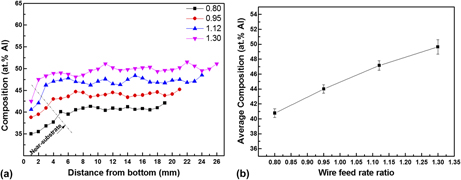Crossref Citations
This article has been cited by the following publications. This list is generated based on data provided by
Crossref.
Ding, Donghong
Pan, Zengxi
Cuiuri, Dominic
and
Li, Huijun
2015.
Wire-feed additive manufacturing of metal components: technologies, developments and future interests.
The International Journal of Advanced Manufacturing Technology,
Vol. 81,
Issue. 1-4,
p.
465.
Tang, H.P.
Yang, G.Y.
Jia, W.P.
He, W.W.
Lu, S.L.
and
Qian, M.
2015.
Additive manufacturing of a high niobium-containing titanium aluminide alloy by selective electron beam melting.
Materials Science and Engineering: A,
Vol. 636,
Issue. ,
p.
103.
Ma, Yan
Cuiuri, Dominic
Shen, Chen
Li, Huijun
and
Pan, Zengxi
2015.
Effect of interpass temperature on in-situ alloying and additive manufacturing of titanium aluminides using gas tungsten arc welding.
Additive Manufacturing,
Vol. 8,
Issue. ,
p.
71.
Ma, Yan
Cuiuri, Dominic
Hoye, Nicholas
Li, Huijun
and
Pan, Zengxi
2015.
The effect of location on the microstructure and mechanical properties of titanium aluminides produced by additive layer manufacturing using in-situ alloying and gas tungsten arc welding.
Materials Science and Engineering: A,
Vol. 631,
Issue. ,
p.
230.
Ma, Yan
Cuiuri, Dominic
Li, Huijun
Pan, Zengxi
and
Shen, Chen
2016.
The effect of postproduction heat treatment on γ-TiAl alloys produced by the GTAW-based additive manufacturing process.
Materials Science and Engineering: A,
Vol. 657,
Issue. ,
p.
86.
Shen, Chen
Pan, Zengxi
Cuiuri, Dominic
Dong, Bosheng
and
Li, Huijun
2016.
In-depth study of the mechanical properties for Fe3Al based iron aluminide fabricated using the wire-arc additive manufacturing process.
Materials Science and Engineering: A,
Vol. 669,
Issue. ,
p.
118.
Shen, Chen
Pan, Zengxi
Cuiuri, Dominic
Ding, Donghong
and
Li, Huijun
2017.
Influences of deposition current and interpass temperature to the Fe3Al-based iron aluminide fabricated using wire-arc additive manufacturing process.
The International Journal of Advanced Manufacturing Technology,
Vol. 88,
Issue. 5-8,
p.
2009.
Dong, Bosheng
Pan, Zengxi
Shen, Chen
Ma, Yan
and
Li, Huijun
2017.
Fabrication of Copper-Rich Cu-Al Alloy Using the Wire-Arc Additive Manufacturing Process.
Metallurgical and Materials Transactions B,
Vol. 48,
Issue. 6,
p.
3143.
Gasper, A.N.D.
Catchpole-Smith, S.
and
Clare, A.T.
2017.
In-situ synthesis of titanium aluminides by direct metal deposition.
Journal of Materials Processing Technology,
Vol. 239,
Issue. ,
p.
230.
David, S. A.
and
Deevi, S. C.
2017.
Welding of unique and advanced ductile intermetallic alloys for high-temperature applications.
Science and Technology of Welding and Joining,
Vol. 22,
Issue. 8,
p.
681.
Yu, Yongze
Liu, Fujun
and
Liu, Jing
2017.
Direct 3D printing of low melting point alloy via adhesion mechanism.
Rapid Prototyping Journal,
Vol. 23,
Issue. 3,
p.
642.
Hao, Zhizhuang
Ao, Sansan
Cai, Yangchuan
Zhang, Wei
and
Luo, Zhen
2018.
Formation of SUS304/Aluminum Alloys Using Wire and Arc Additive Manufacturing.
Metals,
Vol. 8,
Issue. 8,
p.
595.
Shen, Chen
Pan, Zengxi
Cuiuri, Dominic
van Duin, Stephen
Luo, Dongzhi
Dong, Bosheng
and
Li, Huijun
2018.
Influences of postproduction heat treatment on Fe3Al-based iron aluminide fabricated using the wire-arc additive manufacturing process.
The International Journal of Advanced Manufacturing Technology,
Vol. 97,
Issue. 1-4,
p.
335.
Shen, Chen
Liss, Klaus-Dieter
Reid, Mark
Pan, Zengxi
Ma, Yan
Li, Xi
and
Li, Huijun
2019.
In-situ neutron diffraction characterization on the phase evolution of γ-TiAl alloy during the wire-arc additive manufacturing process.
Journal of Alloys and Compounds,
Vol. 778,
Issue. ,
p.
280.
Gurianov, D A
Kalashnikov, K N
Osipovich, K S
and
Chumaevskii, A V
2019.
Obtaining the bimetallic composition by the electron beam freeform fabrication.
IOP Conference Series: Materials Science and Engineering,
Vol. 597,
Issue. 1,
p.
012043.
Wang, Jun
Pan, Zengxi
Wei, Liangliang
He, Shuai
Cuiuri, Dominic
and
Li, Huijun
2019.
Introduction of ternary alloying element in wire arc additive manufacturing of titanium aluminide intermetallic.
Additive Manufacturing,
Vol. 27,
Issue. ,
p.
236.
Du, Farui
Zhu, Jinqian
Ding, Xueping
Zhang, Qi
Ma, Honglin
Yang, Jie
Cao, Hongzhong
Ling, Zemin
Wang, Guoyu
Duan, Xuanming
and
Fan, Shuqian
2019.
Dimensional characteristics of Ti-6Al-4V thin-walled parts prepared by wire-based multi-laser additive manufacturing in vacuum.
Rapid Prototyping Journal,
Vol. 25,
Issue. 5,
p.
849.
Zhu, Hanliang
Ma, Yan
Wei, Tao
Li, Huijun
Aughterson, Robert
and
Lumpkin, Gregory
2019.
The formation and Kr-ion irradiation behaviour of new microstructural features in additively manufactured titanium aluminium alloy.
Additive Manufacturing,
Vol. 29,
Issue. ,
p.
100766.
Pelleg, Joshua
2020.
Additive and Traditionally Manufactured Components.
p.
49.
Zhu, Hanliang
Qin, Mengjun
Aughterson, Robert
Wei, Tao
Lumpkin, Gregory
Ma, Yan
and
Li, Huijun
2020.
The formation and accumulation of radiation-induced defects and the role of lamellar interfaces in radiation damage of titanium aluminum alloy irradiated with Kr-ions at room temperature.
Acta Materialia,
Vol. 195,
Issue. ,
p.
654.



